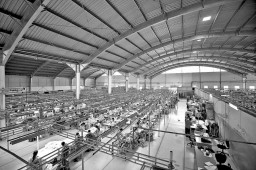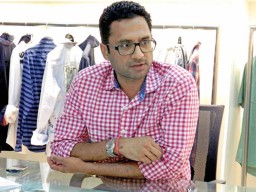
A niche player in the market, Radhamani Textiles is working for some of the most product focused companies in the world including Tom Tailor, Gaastra, Napapijri, River Island , Zara man and boys, Jules, Camp David, sOliver to name a few and even has its own brand POE. This Rs. 135-crore company, which specializes in men’s shirts, has a consolidated manufacturing facility at a 10 acre site near Bangalore with a manufacturing capacity of 3 million pieces a year. Working on production systems that are generally seen in Italian manufacturing companies and is unique to India, the company is getting value from working directly with the customers, offering fabric development in quick turnarounds. As manufacturing gets expensive, the company realized that unit price, design, tight control on supply and manufacturing cost, and timely deliveries contribute to the success story.
Design Values – Unit Realization Escalation

“Since product development is at the core of this company, a team of designers led by me constantly travels and interacts with buyers to understand trends and forecast collections. From the colour palette to value addition to detailing are evaluated for each individual buyer and collections created keeping their market segmentation and positioning in mind,” says Manish Poddar, Director, Radhamani Textiles. On the basis of the design, Radhamani plans to bring in more value-added brands in the coming years, which then can ultimately increase their unit realization in the shirt category. “Unlike industry norms where the shirt business has taken a beating in prices as buyers are always making a comparison with Bangladesh or other countries, we decided to stick to our core strength – design, and allocate more and more capacity directly to brands rather than to the price-sensitive buyers,” says Manish. This deep intervention in design has resulted in the company already hitting an average realization price of $ 10 per piece, and which is expected to go up to $ 14 next year, a way above the industry average of around $ 4 per piece.
The corporate culture around the world is to spend 20 per cent of gross profit on R&D, which is unheard of in the garment industry. However, Radhamani tends to differ and to offer product differentiation, it has setup a world class design studio at their corporate office and allocated a defined budget for product development and trend search to execute collections. “Our return on the investments and new developments is almost 85 per cent,” shares Manish. No wonder, Radhamani is catering to most of the influential lifestyle brands of Europe today and is hunting for more.
Supply Chain Efficiency
Today, all segments of the supply chain has concerns of volatility in their raw material supplies. They need projections and capacity allocations with good financial backing to standby the commitments; Radhamani recognizes this and believes in narrow and deep supply partners to derive priority and service for the ultimate customers. It is an era of trust and partnerships and Radhamani has imbibed the same culture in its supply chain, aligning with India’s leading manufacturers for fabric. “Our business is salesman sample based and we need to give priority to all our customers, as all of them are participants to most of the international garment fairs at the same time. Without a firm commitment month after month, one cannot expect service in today’s world,” avers Manish.
Taking service to a higher level, Radhamani also takes joint risks with their customers in meeting price points and developing/customizing fabrics for them. This allows the buyers to benefit from quick response and faster deliveries, based on pre launched and approved fabrics. This unique model of joint risk helps both the buyer and the supplier in today’s challenging markets. Of course for such risk-taking, there is a premium which the company charges to the customer for holding the fabrics. “Yet 95 per cent of the times the risk we have taken on fabric developments have paid off,” informs Manish. It is because of this ‘on the toe’ service that the fabric suppliers contribute to Radhamani’s efforts to respond to buyers’ demands, that the company merely has a 0.35 per cent airfreight contribution in a turnover of Rs. 135 crore, which is much below industry norms.
Manufacturing Cost
As manufacturing becomes expensive, it is critical to control prices to maintain healthy bottomlines. Though the company manufactures high-end garments with various prints, value adds and embellishments going into the products, a deep study has gone into devising a method to control the cost of manufacturing. After a lot of research, the company has adapted a system which the Italians call RELOOK and which has been implemented in their internal order processing, buying and production monitoring ERP system.

The production model is termed as ‘Mother & Baby Model’ and breaks down all the required operations of a single style well in advance. Within a mother bag various components of a single piece is placed attached with a bar code. From time to time various components from the mother bag are sent for detailing to various departments (printing, embroidery, embellishment, etc.) in baby bags and then reunited in the mother bag after the value addition is complete. The mother bag is sent to the production line for stitching only when all other value added operations are complete. With this system their assembly line of 11-16 operations, on conveyer maintains a throughput of 700-800 pieces in a day. The in-house capacity for printing, embroidery, garment processing and laundry supports the fast production, as they don’t have to outsource any of these value adding processes.
In this production module, components of a style, which is not planned for production in a particular month or day, could be still seen on the floor being made like a fancy collar or cuff for example. This brings optimum utilization of manpower of the facility at any given point of time and no worker is left without a job even for an hour. This high inventory production system is closely monitored by mobile scanners on the shop floor. Radhamani believes that they are the only manufacturers in India to have this unique system as it is all developed in-house by them. The matrix of all production status is monitored and planned for the next day.
New Venture in Retail
Having learnt the retail side of the fashion business working closely with global partners on collections, one of the Directors of Radhamani, Mukesh Poddar sensed that India created a great potential for the type of products that the company is manufacturing. There were many international brands walking in and out of India with no ‘sustainability’ due to price points or fashion too ahead of time, Mukesh gave shape to a new business model, building the brand POE. The first thing that Mukesh realized was that to nullify stock at the end of season was a great challenge in Retail. For this, an all India distribution model was created so that stocks kept moving, whereby they were able to realize a turnover of over Rs. 30 crore in the first 1.5 years of inception of their brand. The retail venture is also a profitable way of clearing fabric developments that did not make their way into international collections.
Besides distribution channels, standalone stores were created and to ensure interest in the brand, a completely unique concept was born. “We wanted to give a plush and chic feeling to our customers and at the same time make fashion affordable to them. The challenge was to make this vision a reality, where we could stand out in terms of our store appearance and carry a signature presentation. Today we have created a store which is also written under copyrights for the interior of our store,” says Mukesh.
He adds, “Customers in India are very shy to trouble the store attendants, thus many a time they do not open the garment and try it out. We wanted to break this wall of reluctance, so our garments are all in the open, no packaging and free for everyone to feel them before they buy. Our display allows the view of the collection at a bird’s eye and freedom for us to demonstrate all the details of the garments, which cannot be possible in a packed format.”
Today in all the malls that POE has standalone stores, Radhamani claims that it has the best sales realization per square feet in that product category, even though most of the stores are on the 1st or the last levels of the malls. “We plan to increase the number of stores, but only in profitable locations as we don’t believe in opening stores for the number game. In our business plan we are also capable to realize and shut operations of non profiting stores,” reasons Mukesh. Over the last 1½ years the company has opened 8 stores and this year also there are plans to open 6 more stores. “We have shown good margins in our inception period itself due to fast fashion inputs (every week) and clearance of stocks from the backend on weekly basis. This year we shall also introduce denims as we have been focusing only on shirts and trousers up till now,” says Mukesh. The brand introduces 30- 40 styles every month and each product is very detailed, more than the products made for exports.
“Retail is an investment into the future and while the handwriting for the casual shirts for youngsters is very international the price is kept just below a thousand rupees to be affordable to the segment that it is targeted at. The vision is to have 100 stores in three years time,” concludes Manish.






